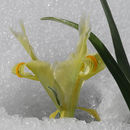en
names in breadcrumbs


Iris palaestina (sometimes Iris palestina) is a species in the genus Iris in the subgenus Scorpiris. It is a bulbous perennial from Asia, including the Palestine region (Israel, the Palestinian Territories and Jordan), Lebanon, Syria and Turkey. It has long, narrow, strap-like leaves, and a short stem. The early blooming, fragrant flowers are greenish-grey/white or yellow-white.
Iris palestina has 1–1.5 in (25–38 mm) ovoid brown bulbs.[2][3]
Most specimens have up to six leaves,[4] which are 6 in (150 mm) tall at flowering time.[3] They are normally about 1–2 cm (0.39–0.79 in) wide at the base of the plant.[5] The long, narrow, strap-like leaves have undulate edges[6] with a thin white margin.[2] They are normally shiny green in color,[7] but are glossy on the upper surface.[2]
It has a short stem which is about 10–20 cm (3.9–7.9 in) high.[2]
It has fragrant flowers between January and February.[3] Generally, there are one to three flowers per stem. The flowers are greenish-grey/white,[8][9] but can be yellow-white as well. In southern Israel, some specimens have a slight blue tinge.[2]
The flowers have winged falls. It has a perianth tube around 8–18 cm (3.1–7.1 in) long.[7]
It has oblong capsules and seeds without arils.[2][5]

It is also known as the Palestine iris,[2] and it is known in Hebrew as איריס ארץ-ישראלי (iris eretz Israeli).[4]
Iris palestina was first found in Mesopotamia, part of Syria, and it was first published in Flora Orientalis by Pierre Edmond Boissier in July 1882.[10]
It was originally thought to be a variety of Iris vartanii.[3] It is similar in form to the better known and more decorative Iris planifolia.[8]
Iris palaestina is an accepted name by the Royal Horticultural Society.[11] It was verified by United States Department of Agriculture and the Agricultural Research Service on 4 April 2003, and then updated on 1 December 2004.[12]
It is native to temperate Asia.[12]
It comes from Turkey, Jordan,[12] Syria,[10] Lebanon,[12] (including Batha[2]) and Israel. It was found in Golan, Galilee, Mediterranean coast, northern valleys, Carmel, Samarian mountains, Samarian desert, Judean mountains, Sharon and Shefela.[4]
It likes open stony soils (with sandstone material)[2] at low altitudes.[5] Normally it is found at coastal sites but is also common within olive groves.[8]
It is hardy to USDA Zone 4.[7]
The iris is not hardy and is generally a poor grower in the UK.[9] It is better grown in a pot under cover in a greenhouse or bulb frame. It should be potted in well-drained, fertile compost and have a summer rest from watering.[6]
It can be found and seen in Tel Aviv University Botanic Garden.[13]
It has been used as a medicinal plant in the Middle East for urinary tract infections by boiling the leaves or the rhizomes in water, similar to the use of Iris pallida.[14]
Iris palaestina (sometimes Iris palestina) is a species in the genus Iris in the subgenus Scorpiris. It is a bulbous perennial from Asia, including the Palestine region (Israel, the Palestinian Territories and Jordan), Lebanon, Syria and Turkey. It has long, narrow, strap-like leaves, and a short stem. The early blooming, fragrant flowers are greenish-grey/white or yellow-white.